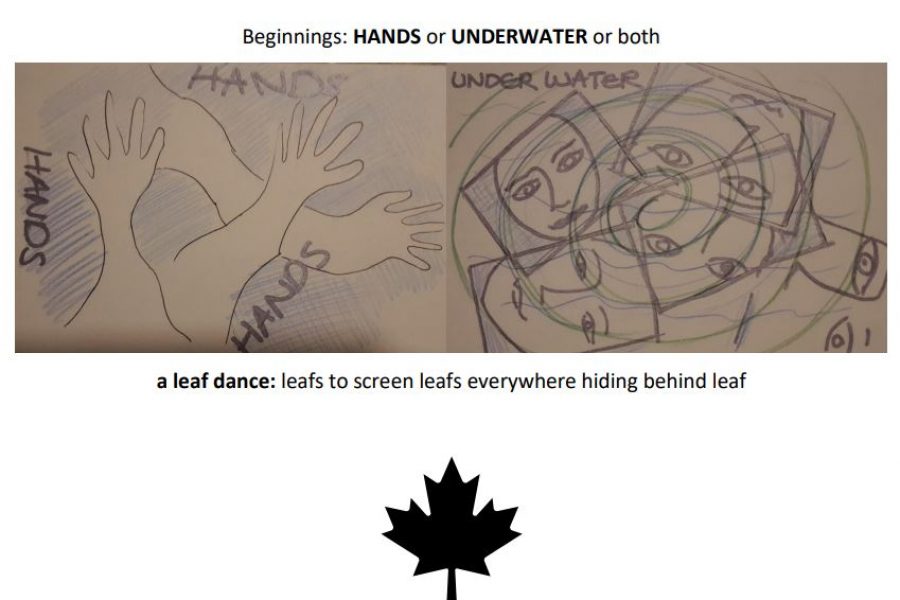Cultivating the unexpected: Creating a working score for improvisation with the Ambient Jam Collective
by Rebecca Swift, Creative Director
The Ambient Jam Collective (AJC) are an ensemble of differently-abled artists who conjure multi-sensory improvisations in different places and spaces.
However hard we prepare in advance for an Ambient Jam improvisation, the event always has a life of its own. To help guide us through an improvisation that might be full of surprises, we create a working score or flexible map.
Working scores can be used in improvisation as a loose or tight structure to help shape content, experiment with ideas, and mediate how a piece might unfold. In the context of the Ambient Jam Collective (AJC), a score is made from ingredients contributed by everyone, such as themes, atmospheres, feelings, objects, sounds, smell, costume, roving leadership, an action or gesture. The different identities of the ensemble are reflected in the score.
In the final event, some of these ingredients will happen, but often not in the order we expect. When elements of the score surface in improvisation, then everyone recognises them and takes them forwards, but equally, the improvisers embrace unplanned things that naturally emerge. Conversely, it is possible to be directive and inject an idea to catalyse a shift or change.
The score is also there to suggest values and boundaries to ensure everything is safe enough to work with the unexpected, where participants can feel comfortable and free to make their own choices whilst remaining connected.
Here is an example of our most recent working score created for the Ambient Jam ‘Between Worlds’ Zoom improvisation and commissioned by the Tavistock Institute’s Deepening Creative Practise (DCP). ‘Between Worlds’ brought together two different groups of people who would not normally connect in society: participants from Deepening Creative Practise, academics, CEO’s, leaders and consultants with the Ambient Jam Collective, including two families and two supported housing participants.
Click here to see the working score
Both groups had separately been exploring the same themes of nature, space, senses, ‘in the field’ and autumn. To prepare, we had a few rehearsals with the collective to throw up ideas for the score; then we facilitated a workshop with participants from DCP sharing our Ambient Jam approaches and etiquettes. Everyone, across both groups, was tasked in sourcing the same objects, such as a hat, a leaf, something the colour blue or orange. Finally, 35 people, some from abroad, came together in one big improvisation on zoom with these objects at hand, none of us certain how the piece would unfold.
Despite all the unknowns within improvisation, everyone draws together. This solidarity and sense of community between participants are what make a piece work.
It can help if scores are aural and visual as well as written since ideas arise just as much through sound, texture, and image and these modes might capture and communicate an atmosphere better than words. The ‘Between Worlds’ score blends images from AJC artists, such as Hannah James’s elemental paintings – acting as prompts for mood-themes explored by both groups – with similar images created by participants on DCP. Everyday objects and stories that bubbled up in rehearsals like Lucy’s hairbrush also have equal status. In the mix are simple practical ideas like spotlighting and break out groups, beginnings, and endings. AJC scores weave ideas together that might initially appear incoherent and yet create cohesion whilst respecting the richness of difference.
In the following extract, DCP participant Marie Beauchamp describes her experience of the ‘Between World’ improvisation:
“What we did yesterday with Ambient Jam was an exercise in equal status. There was so much power in there. There was so much joy going on. People were playing to their fullest self, and I’m not sure I’ve ever been so much myself in a social context ever. Ever. It was so majestic to just let go of all the categories that hold us in place. It was so wonderful to flow along the music, to engage in it, to feel the rhythm of an endless hallo that propelled us in a sense of understanding each-other where words no longer mattered. Because at that moment words could only be a barrier. But beyond those words opened a world of communication channeling love in all its beauty. I was filled with the energy of life in its most poetic expression. In the grandeur of our differences. In the grandeur of the play that was ongoing, propelled by faces and hands and hats and colours and laughter and smiles and eyes that came closer. The texture of our faces searching for the texture of other faces. An eye looking into another eye. There were screens and thousands of kilometers in-between, but the playfulness was stronger. In a space physically together, it would have been so strong that it would have crashed us all against the wall. In bridging the distance that separated us, we pulled all the energy that there was, traversing all frontiers.”
Dr Marie Beauchamps, Marie Skłodowska-Curie postdoc fellow, Queen Mary, School of Politics and International Relations, University of London.


